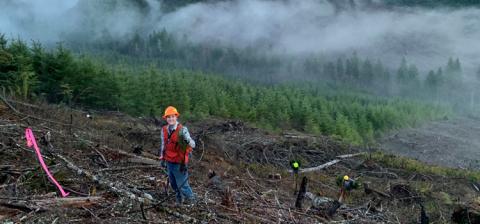How do foresters choose what kinds of trees to plant in Oregon’s forests?
March 24, 2022
As a forester working for Roseburg Forest Products on the west side of the state, I’m frequently asked “Why do you plant so much Douglas-fir?”
Named after Scottish botanist David Douglas, Douglas-fir grows from British Columbia to Mexico, and from the Pacific Ocean all the way east through the Rocky Mountains. It is the state tree of Oregon, and it can grow anywhere from sea level to 5,000 feet in elevation. It prefers full sunlight to really thrive. Native Americans used the wood for fuel, tools and even medicinal purposes. Today, no other tree species in the world compares for wood products.
With all of that said, my short answer to the original question is: Because that’s what belongs here! At Roseburg, the majority of the trees we harvest to make wood products and then replant are Douglas-fir.
Foresters do, however, plant other native tree species when reforesting areas where timber has been harvested in Oregon’s forests. Where I work in southern Oregon, we have many site considerations when deciding which trees to plant. Sometimes the tree species that are present prior to harvest can give us clues to what would work best. Other times, it requires a bit more “detective work,” such as figuring out what type of soil is present on the site or monitoring site conditions throughout the year.
Here are some examples of the different kinds of trees that I may consider planting after a timber harvest, based on the conditions of the site I’m planning to reforest:
- Incense-cedar is a tree that we will often select on sites where we have heavy clay soils. Imagine that red dirt that gets dry, hard and may even crack in the summer. That’s where incense-cedar can thrive. You’ll often find them growing next to our “beloved” poison oak.
- Grand fir can tolerate having its “feet wet” for part of the year – so if you have moist soils on your site, this is one that can be planted among Douglas-fir.
- Western redcedar loves having its feet wet and thrives alongside streams, springs and other wet areas.
- The ponderosa pines that we plant at lower elevations on the west side of the state are actually a little different than the ones you find to the east of the Cascades. They grow pretty well just about everywhere in the valley foothills, and can tolerate wet soils better than Douglas-fir.
- Redwood is a great option for coastal sites where Douglas-fir may suffer from ailments such as Swiss needle cast. It’s an amazingly fast grower and can even re-sprout when cut!
That’s all to say that while Roseburg plants a lot of Douglas-fir, it’s also important to plant a variety of tree species on our forestland. Each type of tree needs different conditions to survive and thrive, and not every site is ideally suited for Douglas-fir.
Lawrence Martin Jr.
Forester
Roseburg
